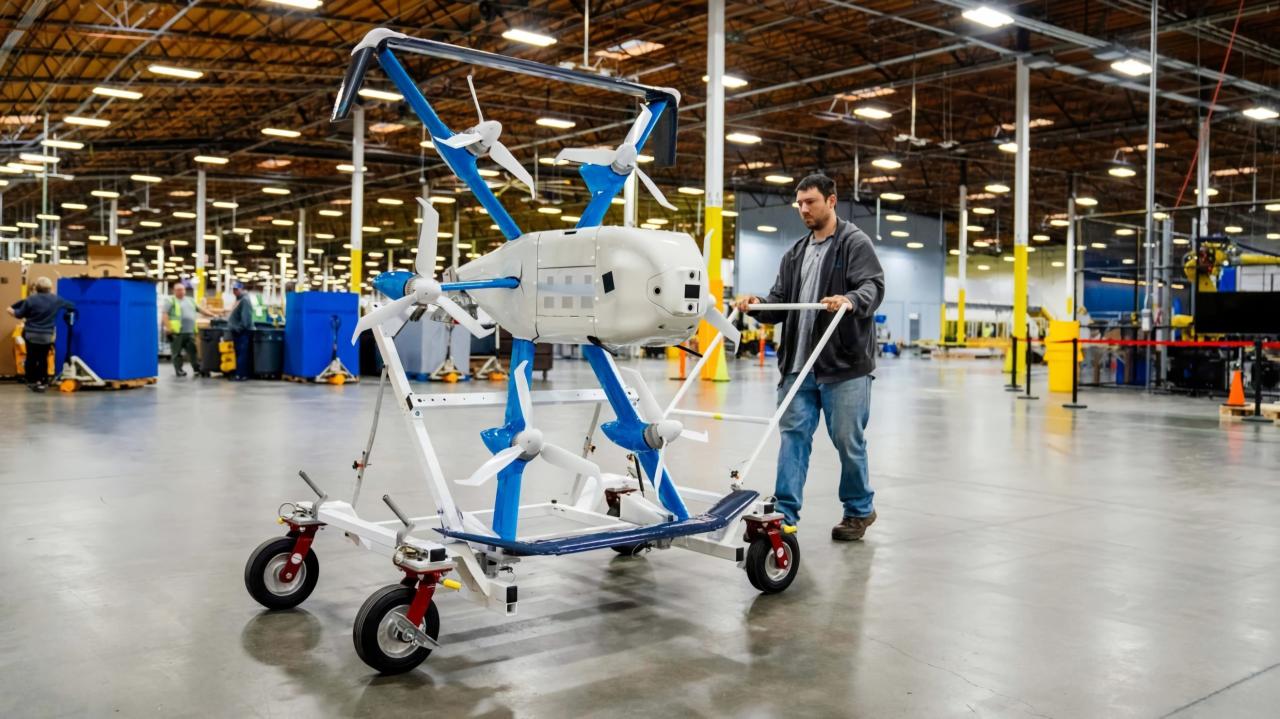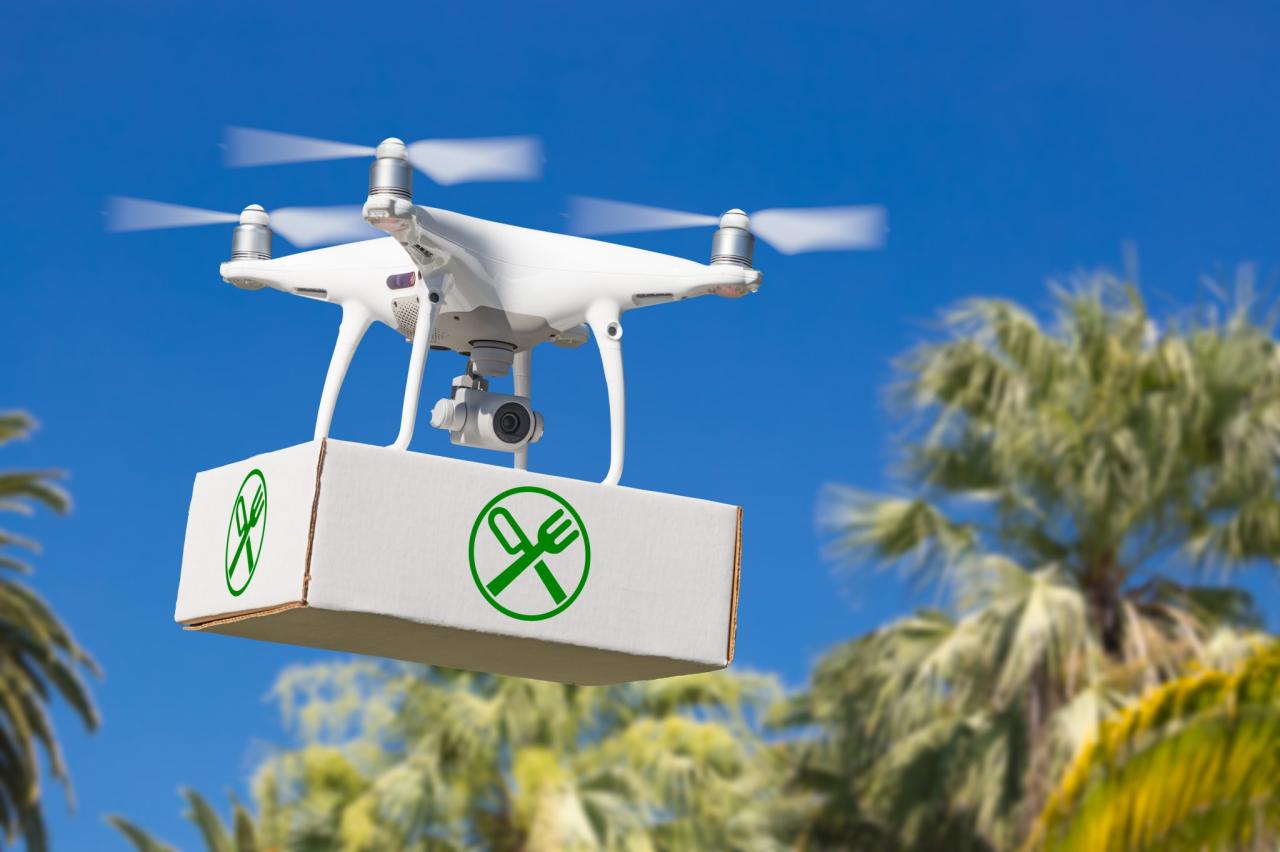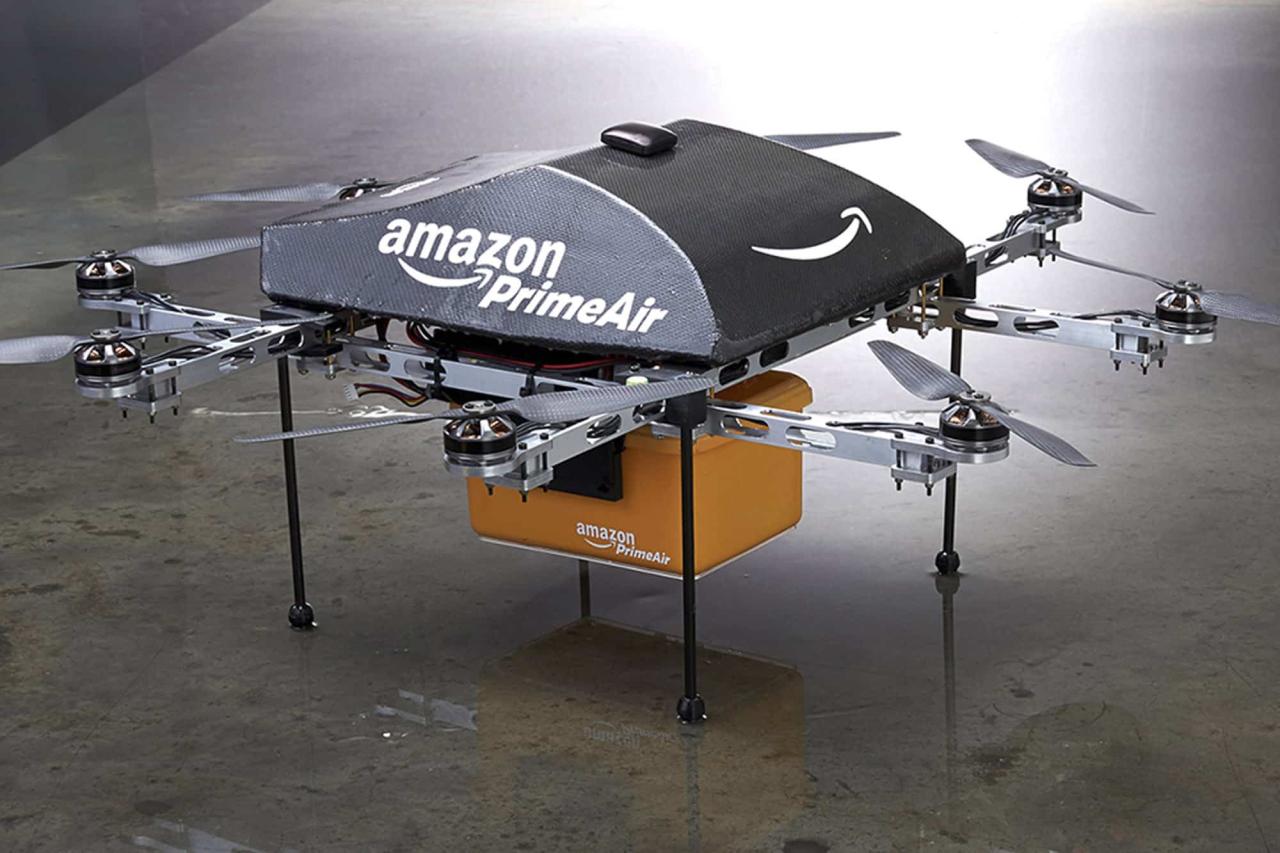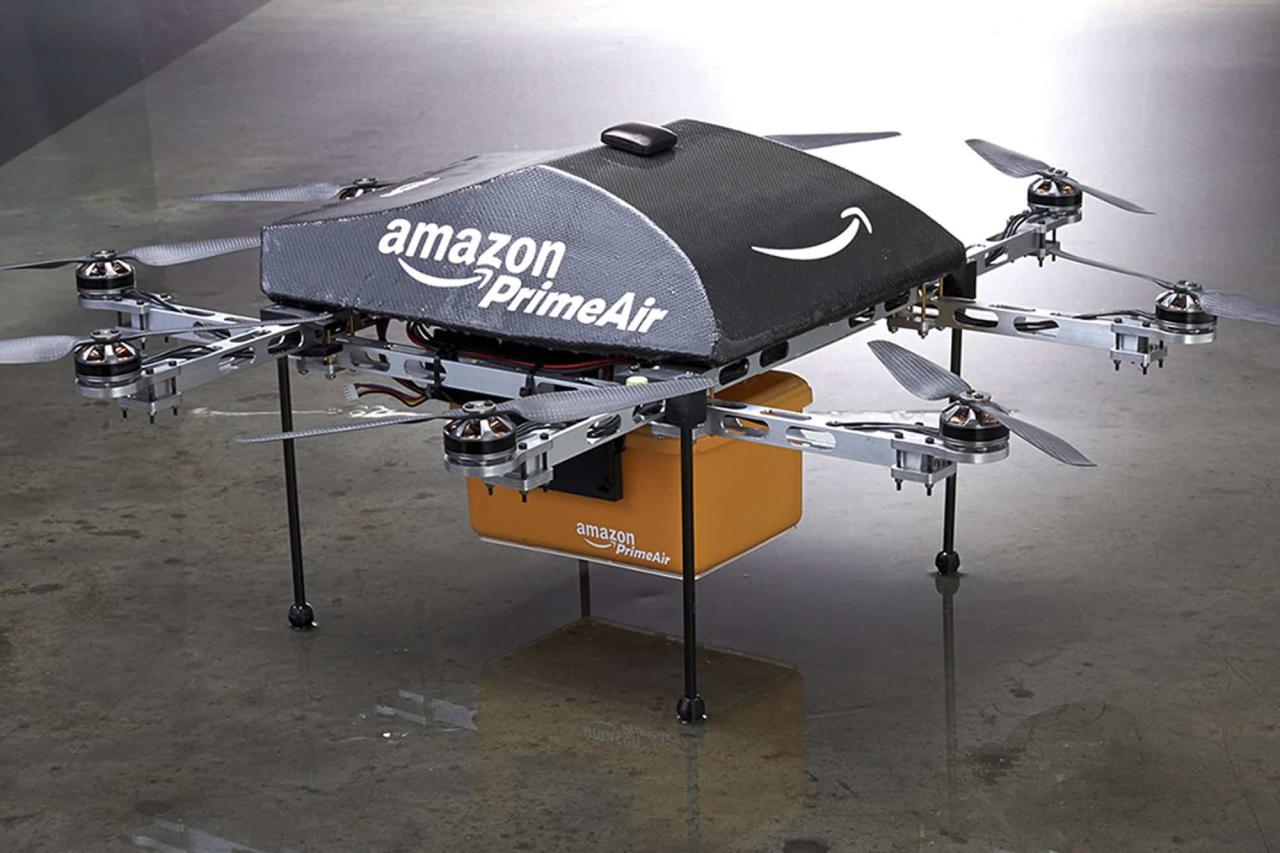Amazon drone delivery locations are rapidly expanding, revolutionizing how we receive packages. This exploration delves into the current state of Amazon’s drone delivery program, examining its geographic reach, infrastructure needs, customer experiences, regulatory hurdles, environmental impact, technological advancements, and economic implications. We’ll cover everything from the types of packages eligible for drone delivery to the challenges of integrating this technology into existing urban landscapes.
Get ready for a comprehensive look at the future of package delivery!
From the initial test flights to the current operational areas, we’ll trace the evolution of Amazon’s drone delivery network. We’ll also analyze the technological innovations driving this progress, the regulatory landscape shaping its expansion, and the economic opportunities and challenges it presents for communities across the nation. The goal is to provide a clear, concise, and informative overview of this transformative technology.
Amazon Drone Delivery Program: A Comprehensive Overview
Amazon’s drone delivery program represents a significant leap in logistics technology, aiming to revolutionize the speed and efficiency of package delivery. This overview examines the program’s current status, infrastructure needs, customer experience, regulatory landscape, environmental impact, technological underpinnings, and economic implications.
Current Amazon Drone Delivery Program Status

Amazon’s drone delivery service, officially known as Amazon Prime Air, is currently operating in a limited geographic area. The program’s expansion has been gradual, focusing on refining technology and navigating regulatory hurdles. The types of packages eligible for drone delivery are typically smaller and lighter items that can be safely transported within the drone’s weight and size limitations.
Amazon’s expanding drone delivery network is covering more ground, aiming to reach more remote areas. However, the recent incident involving a drone show crash highlights the inherent risks in drone technology. This underscores the need for robust safety protocols as Amazon continues to develop its drone delivery locations and expand its service.
| State | City | Start Date (Approximate) | Number of Deliveries (Estimated) |
|---|---|---|---|
| California | Lockeford | 2022 | Thousands |
| Texas | College Station | 2022 | Hundreds |
| Arkansas | Fayetteville | 2023 | Hundreds |
| Tennessee | Clarksville | 2023 | Hundreds |
Key milestones in the program’s expansion include initial testing phases, securing regulatory approvals, and the gradual rollout of drone delivery services to select communities. The company continues to expand its operational areas based on successful trials and regulatory developments.
Infrastructure Requirements for Drone Delivery Locations

Establishing drone delivery locations requires a carefully planned infrastructure to ensure safe and efficient operations. This includes specialized landing pads, robust communication networks, and stringent safety protocols.
Infrastructure needs differ significantly between urban and rural environments:
- Urban Locations: Require densely spaced, secure landing pads integrated into existing urban infrastructure, advanced obstacle avoidance systems, and sophisticated air traffic management systems to avoid collisions with other aircraft and obstacles. Challenges include finding suitable locations for landing pads in densely populated areas, securing necessary permits and approvals, and addressing noise concerns.
- Rural Locations: Generally require less complex infrastructure, with landing pads located in open areas. However, challenges include ensuring reliable communication networks and addressing potential weather-related delays.
Integrating drone delivery infrastructure into existing urban environments presents significant challenges. These include securing airspace access, navigating complex regulations, and addressing concerns about noise pollution and public safety.
Customer Experience and Feedback
Early customer testimonials highlight the speed and convenience of drone delivery. Many customers appreciate the quick delivery times, particularly for smaller, time-sensitive items. However, some customers have reported issues with package tracking and occasional delivery delays due to weather conditions or technical problems.
A hypothetical customer satisfaction survey could include questions on:
- Delivery speed
- Reliability of the service
- Ease of use of the system
- Overall satisfaction with the drone delivery experience
- Suggestions for improvement
Based on feedback, potential improvements could include enhanced package tracking capabilities, improved communication during delivery delays, and expansion of service areas to cover a wider range of locations.
Regulatory and Legal Aspects, Amazon drone delivery locations

Drone delivery operations are subject to a complex web of regulations that vary by location. These regulations address airspace usage, safety protocols, and data privacy.
| Regulation Type | Governing Body | Key Requirements |
|---|---|---|
| Airspace Authorization | Federal Aviation Administration (FAA) | Securing necessary permits and approvals for drone flights. |
| Safety Standards | FAA, National Transportation Safety Board (NTSB) | Compliance with drone safety standards, including operational limitations and maintenance requirements. |
| Data Privacy | Federal Trade Commission (FTC), state-level agencies | Protection of customer data collected during drone delivery operations. |
Differing regulations across jurisdictions can significantly impact the expansion of drone delivery services. Amazon needs to navigate these complexities to ensure compliance and facilitate broader implementation.
Environmental Impact of Drone Delivery
The environmental impact of drone delivery is a complex issue with both benefits and drawbacks. Compared to traditional delivery methods, drones offer potential advantages in terms of reduced fuel consumption and emissions, especially for short-distance deliveries.
| Metric | Traditional Delivery (Truck) | Drone Delivery |
|---|---|---|
| Fuel Consumption | High (varies by distance) | Low (per delivery) |
| Emissions | High (CO2, NOx, etc.) | Lower (depending on drone technology) |
| Noise Pollution | Moderate to High | Moderate (potential for noise reduction with advanced technology) |
Amazon is actively exploring strategies to minimize the environmental impact of its drone operations, such as using electric drones and optimizing delivery routes. The long-term environmental sustainability of large-scale drone delivery depends on the continued development of cleaner energy sources and more efficient drone technology.
Amazon’s expanding drone delivery network is aiming for wider coverage, with test locations popping up across the US. However, incidents like the recent drone crash in Paris highlight the safety challenges involved in widespread drone operations. This underscores the need for robust safety protocols as Amazon continues to develop its drone delivery locations and expands its services.
Technological Aspects of Amazon Drone Delivery

Amazon’s delivery drones utilize advanced technologies for autonomous navigation, obstacle avoidance, and package handling. These include sophisticated GPS systems, computer vision algorithms, and automated package release mechanisms.
Amazon’s expanding drone delivery locations are pretty cool, right? It makes you wonder about the tech involved and the potential for things to go wrong, like that recent drone show crash which highlighted the importance of safety protocols. Hopefully, Amazon’s rigorous testing means their drone deliveries will remain incident-free, expanding their reach to even more areas soon.
Comparing Amazon’s drone technology to competitors reveals some key differences:
- Range and Payload: Amazon’s drones are designed for a specific range and payload capacity, optimizing for short-distance deliveries of smaller packages. Competitors may focus on longer ranges or heavier payloads.
- Obstacle Avoidance: Amazon utilizes advanced sensor technologies for obstacle avoidance, while competitors may employ different sensor suites or algorithms.
- Automation Level: Amazon’s drones operate with a high degree of autonomy, while some competitors may rely on more human-in-the-loop systems.
Future advancements in drone technology, such as improved battery technology, more sophisticated AI algorithms, and enhanced sensor capabilities, could significantly enhance Amazon’s delivery services, potentially increasing range, payload capacity, and operational efficiency.
Economic Impact of Drone Delivery Locations
Establishing drone delivery locations can have both positive and negative economic impacts on communities. Potential benefits include job creation in manufacturing, operations, and maintenance, as well as increased consumer spending and economic growth.
A hypothetical economic impact assessment for a specific location might consider factors such as job creation in drone manufacturing and maintenance, investment in drone infrastructure (landing pads, communication networks), and increased consumer spending due to the convenience of drone delivery. For example, in a rural area, drone delivery could support local businesses by providing efficient access to wider markets, potentially leading to job growth in those businesses as well.
Final Thoughts
Amazon’s drone delivery program is not just a technological marvel; it’s a dynamic system reshaping logistics, customer expectations, and even the environmental impact of package delivery. While challenges remain—from regulatory hurdles to infrastructural complexities—the potential benefits are undeniable. As technology continues to advance and regulations evolve, we can anticipate a future where drone delivery becomes an increasingly integral part of our daily lives, offering speed, efficiency, and perhaps even environmental sustainability.
Popular Questions: Amazon Drone Delivery Locations
What is the weight limit for packages delivered by Amazon drones?
The weight limit varies depending on the drone model and package dimensions, but generally, it’s limited to smaller, lighter packages.
How do I know if my location is eligible for Amazon drone delivery?
Check the Amazon website or app. Eligibility is based on location and package type.
What happens if the drone encounters bad weather during delivery?
Amazon’s drones are equipped with weather sensors and will automatically return to base if conditions become unsafe. The delivery will be rescheduled.
Are there any security measures in place to prevent package theft?
Amazon employs various security measures, including GPS tracking and secure delivery mechanisms to minimize the risk of theft.
